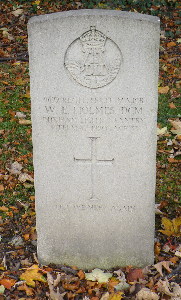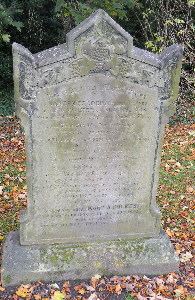
Photo: Dorothy Hall

Photo: Dorothy Hall
9672 Regtl. Serj. Major
W.E. Holmes D.C.M
Durham Light Infantry
16th May 1920 Age 33
Till we meet again
Third son of Mary Ann Holmes, of 6, Hall St., Barnard Castle, and the late Walter Holmes.
A family headstone nearby reads:-
In loving memory of
Joseph Frederick the beloved
child of Walter and M.A. Holmes
who died Oct. 8th 1895 aged 1 year 7 months
also their son died in infancy
They are not dead but sleep
Also Thomas their second son who died Aug. 30th
1907 aged 27 years
With Christ which is far better
Also of the above Walter Holmes
who died July 16th 1911 aged 58 years
And of William Edward Reg. Sergt.
Major D.C.M. late of the 2nd and 7th
Durham Light Infantry third son
of the above who entered into rest
May 16th 1920 aged 33 years
Thy will be done
Also of the above Mary A. Holmes
who entered into rest Oct. 30th 1936
aged 83 years
One of the best the earth contained
Peter Wise and Brenda McMahon have submitted the following:-
William Edward who was born at Barnard Castle on 16 April 1897 was the son of Walter and Mary Holmes. His siblings were Margaret, Walter, Thomas, Sarah Jane and Louisa. His father, from Suffolk, was an omnibus driver.
By 1901 they were probably a bit better off as apart from father, Walter working son Thomas also had a job as a foundry labourer. Two boarders were also living with the family at 6 Hall Street.
On 26th September 1906 William enlisted into the army at Newcastle. His engagement period was shown to be seven years with the Colours and five years with the Reserve. His original service number was 8608.
His records show him to be 5’ 8” tall, with a fair complexion, grey eyes and brown hair. His distinguishing marks were noted as 2 warts. His trade was previously a tailor.
By 1911 William with the Durham Light Infantry was stationed at St Andrew, Newcastle. His rank was corporal and he was an acting school master.
William had been associated with DLI for over 13 years. His service began in Ireland and then he returned home as an instructor. In 1913 it was recorded on his military records that he was sober, trustworthy and willing. His character was noted as being very good. He was also a first class shot. His faith was Church of England.
In February 1918 the Teesdale Mercury reported his visit to Barnard Castle whilst on furlough. He was described as 'gallant', 'unassuming' and 'most interesting in conversation'
Later at the front (30th October 1918) he was awarded the Distinguished Conduct Medal ‘for conspicuous gallantry and devotion to duty when sent back for ammunition for a party without any, he went to a dump under heavy machine gun and rifle fire and obtained it. The horses on the limber were killed on the return to the line, but he succeeded in getting the ammunition to the trench. The conduct of this warrant officer during the whole battle was exemplary.
After the war had ended he served in Italy where he became ill. His medical records are difficult to read but there is a reference to rheumatic fever in 1907 which is known to weaken the heart. It is also noted that there was an infarction to the spleen.
He was admitted to Catterick Military Hospital on January 28th 1920 with heart problems and was treated there for several months. It was agreed he should be sent to York Military Hospital on May 6th 1920 for further treatment but after only 10 days he succumbed to his illness on 16th May 1920.
Probate granted to his mother amounted to £449.4s.6d
William Edward Holmes is remembered at Barnard Castle on B135.02, B135.23 and B135.25

